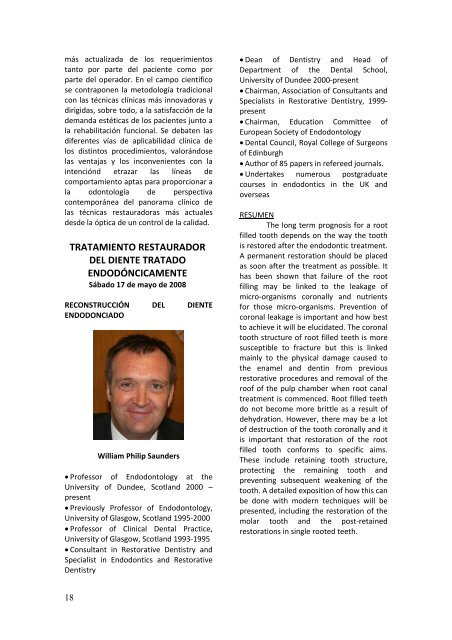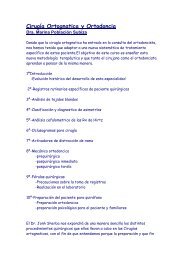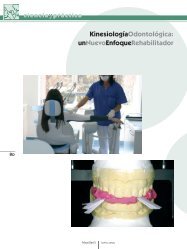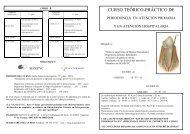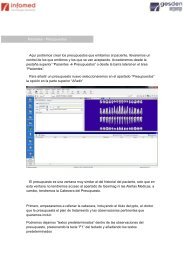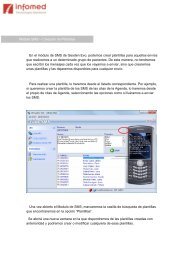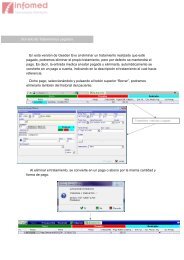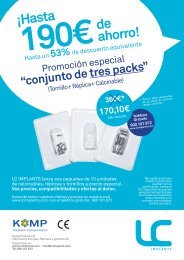resúmenes de comunicaciones de estudiantes - Infomed Dental
resúmenes de comunicaciones de estudiantes - Infomed Dental
resúmenes de comunicaciones de estudiantes - Infomed Dental
You also want an ePaper? Increase the reach of your titles
YUMPU automatically turns print PDFs into web optimized ePapers that Google loves.
más actualizada <strong>de</strong> los requerimientos<br />
tanto por parte <strong>de</strong>l paciente como por<br />
parte <strong>de</strong>l operador. En el campo científico<br />
se contraponen la metodología tradicional<br />
con las técnicas clínicas más innovadoras y<br />
dirigidas, sobre todo, a la satisfacción <strong>de</strong> la<br />
<strong>de</strong>manda estéticas <strong>de</strong> los pacientes junto a<br />
la rehabilitación funcional. Se <strong>de</strong>baten las<br />
diferentes vías <strong>de</strong> aplicabilidad clínica <strong>de</strong><br />
los distintos procedimientos, valorándose<br />
las ventajas y los inconvenientes con la<br />
intenciónd etrazar las líneas <strong>de</strong><br />
comportamiento aptas para proporcionar a<br />
la odontología <strong>de</strong> perspectiva<br />
contemporánea <strong>de</strong>l panorama clínico <strong>de</strong><br />
las técnicas restauradoras más actuales<br />
<strong>de</strong>s<strong>de</strong> la óptica <strong>de</strong> un control <strong>de</strong> la calidad.<br />
18<br />
TRATAMIENTO RESTAURADOR<br />
DEL DIENTE TRATADO<br />
ENDODÓNCICAMENTE<br />
Sábado 17 <strong>de</strong> mayo <strong>de</strong> 2008<br />
RECONSTRUCCIÓN DEL DIENTE<br />
ENDODONCIADO<br />
William Philip Saun<strong>de</strong>rs<br />
• Professor of Endodontology at the<br />
University of Dun<strong>de</strong>e, Scotland 2000 –<br />
present<br />
• Previously Professor of Endodontology,<br />
University of Glasgow, Scotland 1995‐2000<br />
• Professor of Clinical <strong>Dental</strong> Practice,<br />
University of Glasgow, Scotland 1993‐1995<br />
• Consultant in Restorative Dentistry and<br />
Specialist in Endodontics and Restorative<br />
Dentistry<br />
• Dean of Dentistry and Head of<br />
Department of the <strong>Dental</strong> School,<br />
University of Dun<strong>de</strong>e 2000‐present<br />
• Chairman, Association of Consultants and<br />
Specialists in Restorative Dentistry, 1999‐<br />
present<br />
• Chairman, Education Committee of<br />
European Society of Endodontology<br />
• <strong>Dental</strong> Council, Royal College of Surgeons<br />
of Edinburgh<br />
• Author of 85 papers in refereed journals.<br />
• Un<strong>de</strong>rtakes numerous postgraduate<br />
courses in endodontics in the UK and<br />
overseas<br />
RESUMEN<br />
The long term prognosis for a root<br />
filled tooth <strong>de</strong>pends on the way the tooth<br />
is restored after the endodontic treatment.<br />
A permanent restoration should be placed<br />
as soon after the treatment as possible. It<br />
has been shown that failure of the root<br />
filling may be linked to the leakage of<br />
micro‐organisms coronally and nutrients<br />
for those micro‐organisms. Prevention of<br />
coronal leakage is important and how best<br />
to achieve it will be elucidated. The coronal<br />
tooth structure of root filled teeth is more<br />
susceptible to fracture but this is linked<br />
mainly to the physical damage caused to<br />
the enamel and <strong>de</strong>ntin from previous<br />
restorative procedures and removal of the<br />
roof of the pulp chamber when root canal<br />
treatment is commenced. Root filled teeth<br />
do not become more brittle as a result of<br />
<strong>de</strong>hydration. However, there may be a lot<br />
of <strong>de</strong>struction of the tooth coronally and it<br />
is important that restoration of the root<br />
filled tooth conforms to specific aims.<br />
These inclu<strong>de</strong> retaining tooth structure,<br />
protecting the remaining tooth and<br />
preventing subsequent weakening of the<br />
tooth. A <strong>de</strong>tailed exposition of how this can<br />
be done with mo<strong>de</strong>rn techniques will be<br />
presented, including the restoration of the<br />
molar tooth and the post‐retained<br />
restorations in single rooted teeth.


